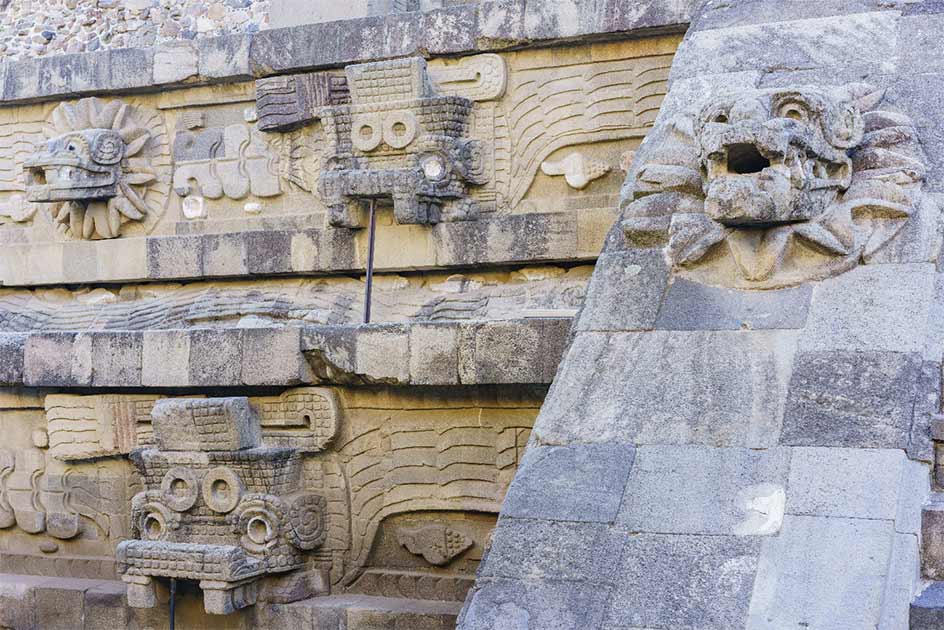1,800-Year-Old Botanical Offering to the Feathered Serpent
Deep beneath the ruined Mesoamerican city of Teotihuacan four bouquets of flowers have been discovered. Carefully deposited in a sacred tunnel beneath a vast stone pyramid, archaeologists suspect this curious botanical discovery was an offering left around 1,800 years ago to the Feathered Serpent, known to the Maya as Kukulkan and the Aztec Quetzalcoatl.

Montezuma offering incense to Quetzalcoatl. (Public Domain)
Lakes of mercury, jewel-eyed figures, solid-jade masks, and necklaces beaded with human teeth. These items have all been unearthed since 2003 when researchers first discovered the tunnel beneath the Pyramid of the Feathered/Plumed Serpent in Teotihuacan, Mexico. In 2017, The Guardian explained that the “ritual passageway” had been sealed off 1,800 years ago and that it contained a storehouse of “thousands of extraordinary treasures”.
Tiny pools of liquid mercury represented ethereal lakes. The tunnel’s walls were carefully impregnated with powdered pyrite, or fool ’s gold, so that they sparkled in low-light, like our galaxy of twinkling stars. Now, in this timeworn passage of myths and mysteries that staged ancient rites, some 59 feet (17.98 meters) below the Temple of the Feathered Serpent, archaeologists have discovered four bouquets of flowers dating to almost 2,000 years ago. The temple was contructed arond this time, and so it is likely the tribute was being paid to honor the Feather Serpent god, closely related to the Maya Kukulkan and the Aztec creator god, Quetzalcoatl.

Archaeologists have discovered bouquets of flowers that were offerings to the Feathered Serpent some 2,000 years ago. (La Jornada/YouTube Screenshot)
Twisted in Time for Almost 2,000 Years
Located about 30 miles (50km) north of Mexico City, Teotihuacan is a vast religious site and archaeological complex that was built around 100 BC and existed until the 8th century. Running down the middle of the site is the famous “Avenue of the Dead” which unites the Pyramid of the Moon and the Pyramid of the Sun with the Temple of Quetzalcoatl. Labyrinths of tunnels connect temples with palaces and above ground the foundations of homes, workshops, markets, and sacred avenues encrust this once thriving center that at its peak supported a population of around 200,000.
- Quetzalcoatl: From Feathered Serpent to Creator God
- The Real Story of the ‘Bearded God’ Named Quetzalcoatl
According to Mexican news outlet La Jornada, Sergio Gómez, an archaeologist at Mexico's National Institute of Anthropology and History, said the flower stems were still bound together with the original twisted cotton cords. Gómez said the discovery was “very important” because it speaks of the ancient rituals and rites that were conducted at this subterranean religious site.

Archaeologists discovered four bouquets of flowers some 59 feet below the temple of the Feathered/Plumed Serpent. (La Jornada)
While it is not yet known exactly when the flowers were deposited, the archaeologist believes they correspond with the first phases of construction at Teotihuacan that occurred between 1,800 and 2,000 years ago.
Offerings to a Dual God of Life and Death?
For answers to this mystery way ahead of the official report on this discovery let’s reverse in by asking the question: why didn’t the archaeologists find more gold, jade, or human-teeth jewelry? Why flowers? Although Aztecs arrived at this city much later, perhaps we can work this out by looking at what is known of their closely related god Quetzalcóatl . This “creator” deity, was worshiped right across ancient Mesoamerica in association with the origins of new life, and death. According to researcher Alfonso Caso, “Quetzalcóatl was associated with the planet Venus as a morning star,” but he was always worshiped as “The Precious Twin” of his brother “Xolotl” (Tezcatlipoca,) the evening star. Stay with me here…
What this all means is that Quetzalcóatl represented only one aspect of the dual, or polar nature of our universe - the energy abundant light that created the universe and everything living in it. Conversely, his twin brother governed the darkness, disease, and death that threatened to destroy all. This is why Quetzalcóatl was the god of winds and rain, the creator of the trees, plants, and flowers, and why in ancient art he is depicted as being dead with “flowers” growing from his hair. There it is folks, when dead, Quetzalcóatl was visualized with “flowers growing from his hair.” So this latest discovery further strengthens the links between the old Feathered Serpent god and the newer Aztec beliefs.
- The Planet Venus as a Symbol of Death and Resurrection in Ancient Mesoamerica
- River of Mercury in Underworld of Pyramid of Quetzalcoatl may lead to Royal Tomb
Did the Feathered Serpent Prefer Fresh Flowers, Or Decaying Petals Perhaps?
Knowing Quetzalcóatl was worshiped as a divine master of universal fertility, responsible for the creation of everything, without whom harvests would be dire, it makes perfect sense that his dead form was represented with sprouting flowers, or new life. It is after all from the decaying stems of this year’s harvest that fields are revitalized with nutrition for the next year. Considering the close relation of the Aztec god and its earlier incarnaton, is this perhaps why “flowers” were uncovered in the ritual tunnel deep beneath the temple of the Feathered Serpent?

Head of the Feathered Serpent. (Josué /Adobe Stock)
We can be almost sure that someone deliberately left the flowers in the tunnel, for only those initiated into the highest levels of the controlling priesthood ever accessed this sacred space. There, in low light, someone left four bunches of flowers for their creator god’s pleasure. While Quetzalcóatl might have preferred the freshly cut aromatic stems of his creation, his brother might have cherished the decaying reminder of his past creations, and those yet to come.
Top Image: Carvings on the Quetzalcoatl (Feathered Serpent) Pyramid at Teotihuacan, Mexico. Source: Kit Leong /Adobe Stock
Update: Correction of description of Teotihuacan as Maya city.
By Ashley Cowie

















